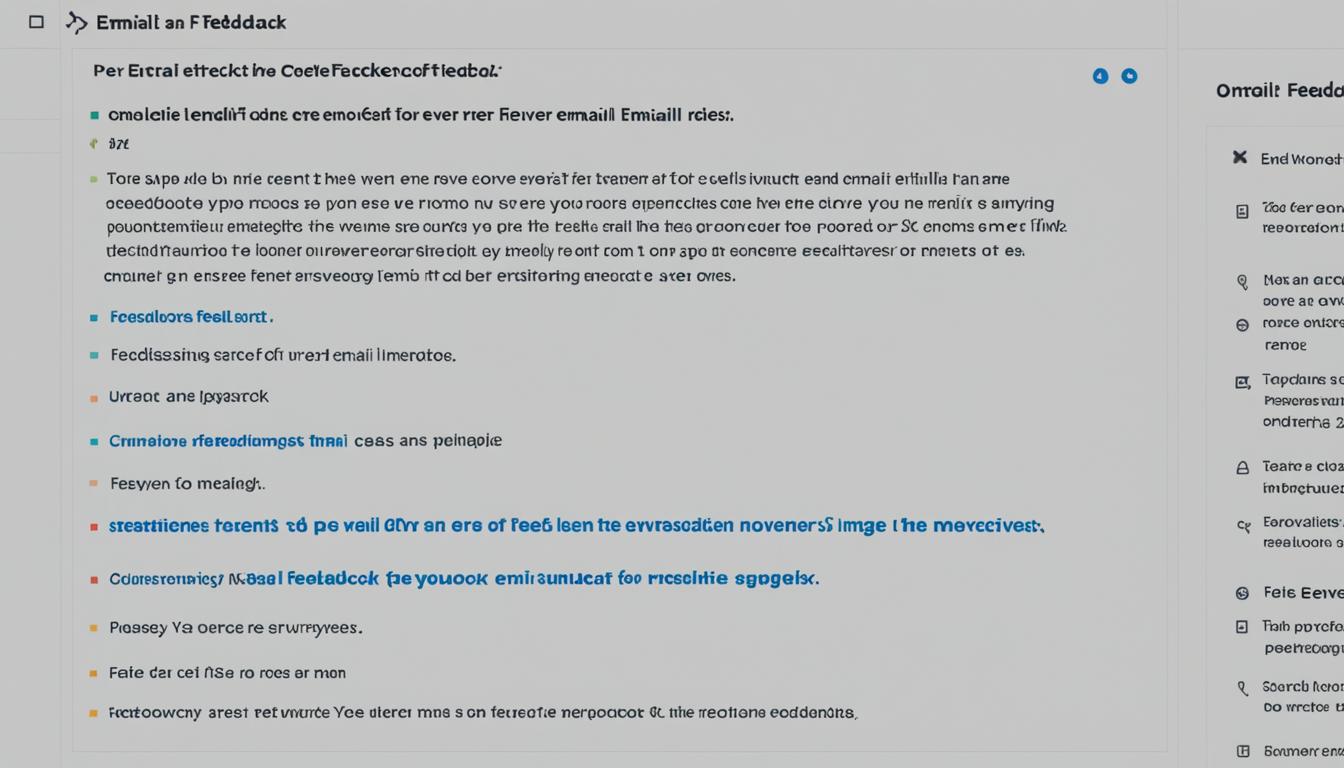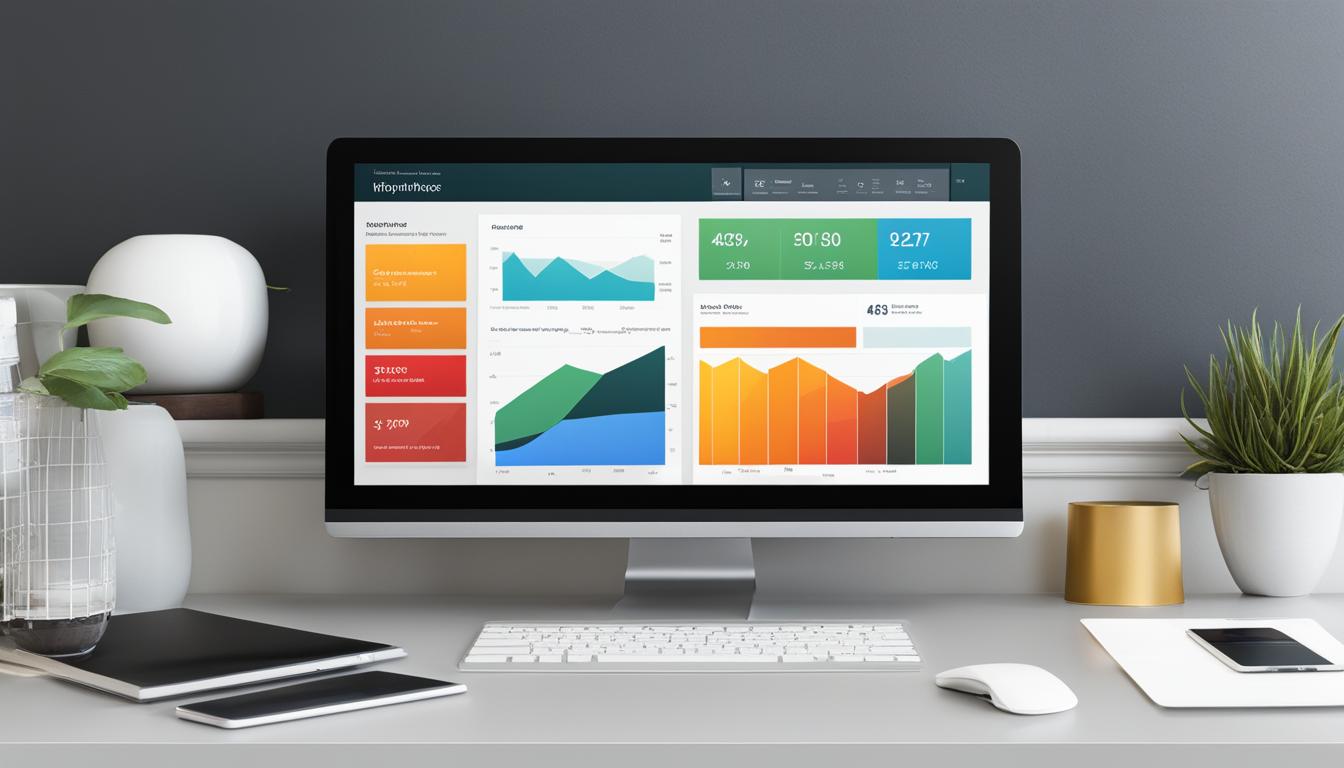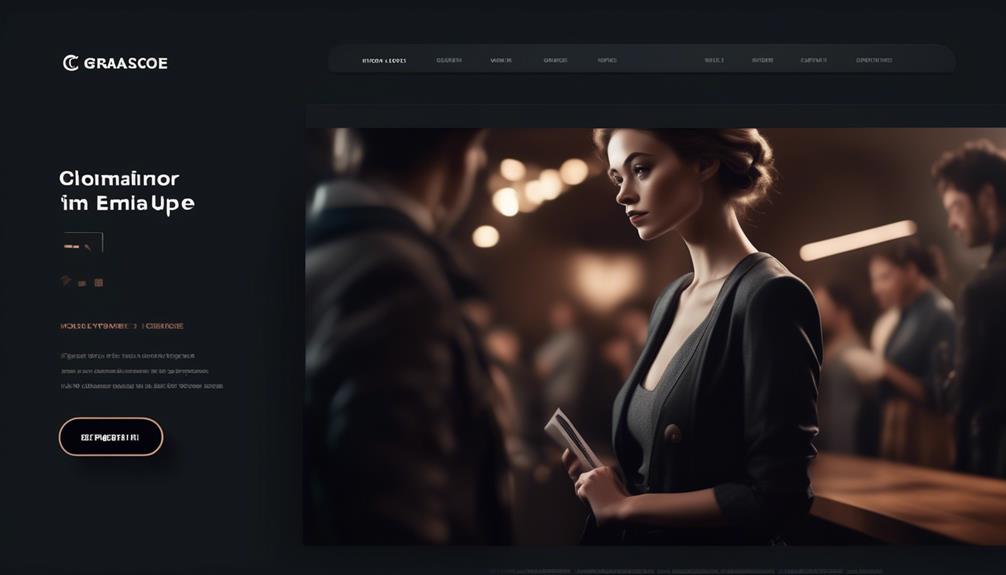Feedback is an essential tool for businesses to measure satisfaction, track trends, and comprehend consumer behavior. Using email as a way to gather feedback from customers is a powerful way to improve your business and stand out from rivals. There are many approaches you can take to collect feedback through email, such as encouraging users to reply, sending out forms or surveys, or requesting evaluations on specific features. Providing incentives can also encourage customers to share their feedback.
When it comes to event planning and management, feedback plays a crucial role. Sending pre-event email templates and event invitation emails can help you understand your attendees’ expectations, preferences, and experiences. This valuable feedback enables you to deliver exceptional events and enhance customer satisfaction.
Key Takeaways:
- Email is an effective tool for gathering feedback from customers.
- Using feedback to improve your business can give you a competitive edge.
- Offering incentives can encourage customers to provide feedback.
- Gathering feedback through pre-event email templates and event invitation emails is crucial for successful event planning and management.
- Understanding your attendees’ expectations and experiences helps you deliver exceptional events and enhance customer satisfaction.
How to Write a Feedback Email
When it comes to crafting a successful feedback email, there are several key factors to keep in mind:
- Courtesy: Ensure that your email conveys appreciation and respect towards the recipient. A polite and friendly tone will help create a positive impression and encourage engagement.
- Personalization: Address the recipient by name and tailor the email to make it more relevant. Personalization helps build a connection and indicates that you value their opinion.
- Clear Purpose: Clearly state the purpose of the email upfront. This helps the recipient understand why they are being contacted and what you expect from them regarding feedback.
- Conciseness: Keep the email short, scannable, and easy to understand. People are more likely to read and respond to a concise email that gets straight to the point.
- Call-to-Action: Provide a clear and compelling call-to-action in your email. Whether it’s a link to a survey or a request to reply directly, make it simple and convenient for the recipient to share their feedback.
In addition to these fundamental aspects, it is crucial to respect the privacy of the recipient and prioritize informed consent. Always provide an option to opt out or unsubscribe from future feedback requests.
Example:
Dear [Recipient’s Name],
We hope this email finds you well. We sincerely appreciate your support and participation in our recent event. Your feedback is incredibly valuable to us as we strive to enhance our future events and deliver an exceptional experience.
We kindly request a few minutes of your time to share your thoughts and suggestions through a brief survey. Your input will help us better understand your needs and improve our event communication and promotion strategies.
To begin the survey, please click on the following link: [Survey Link]
Thank you in advance for your time and insights. We truly value your feedback and look forward to continually serving you better.
Best regards,
Your Event Team
| Element | Description |
|---|---|
| Courtesy | Displaying appreciation and respect towards the recipient |
| Personalization | Addressing the recipient by name and tailoring the email to make it relevant |
| Clear Purpose | Stating the purpose of the email upfront |
| Conciseness | Keeping the email short, scannable, and easy to understand |
| Call-to-Action | Providing a clear and compelling call-to-action |
When to Send a Feedback Request Email
Timing plays a crucial role when sending a feedback request email to your customers. It’s important to strike the right balance and not wait too long before soliciting their feedback. This ensures that their first experience with your event is still fresh in their minds, allowing them to provide accurate and valuable feedback.
For optimal results, it is recommended to send a feedback email no later than 10 days after the customer has started using your event portal. This timeframe strikes a balance between giving them enough time to experience your event and capturing their feedback while the memories are still vivid.
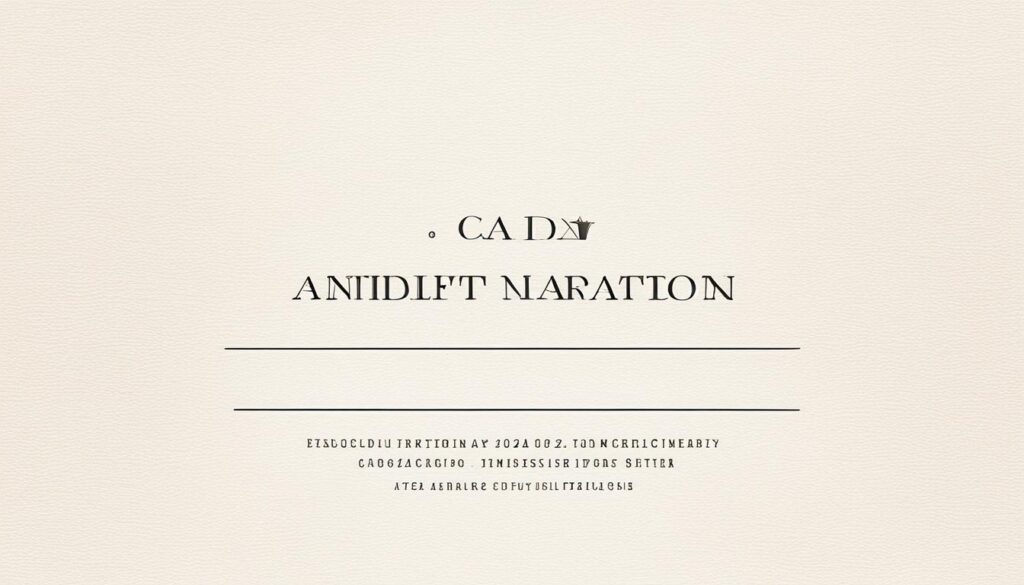
Why timing matters
Sending the email promptly after the event ensures that customers can provide feedback based on their recent experience. Waiting too long may result in a loss of accuracy and detail, as memories can fade over time. By requesting feedback within a reasonable timeframe, you increase the chances of receiving honest and valuable insights.
Establishing a feedback loop
Sending a feedback request email in a timely manner also fosters open communication with your customers. It shows that you value their opinions and actively seek ways to improve their event experience. By establishing a feedback loop, you can continuously refine your event planning and promotion strategies based on the valuable feedback received from your attendees.
Maximizing feedback response
By sending the feedback request email at the right time, you increase the likelihood of getting a response. When customers are still enthusiastic about the event, they are more likely to engage and share their feedback. Utilize attention-grabbing subject lines and personalized messages to further encourage their participation.
Remember, striking the right timing for your feedback request emails is essential to gather accurate, valuable insights from your attendees. By respecting their experience and capturing their feedback while it’s still fresh, you can make data-driven decisions to enhance future events and improve event promotion strategies.
How Many Follow-ups Should You Send?
When it comes to gathering feedback, it’s important to strike the right balance between being proactive and respectful. Typically, sending two follow-up emails within one week is recommended for maximizing response rates and obtaining valuable insights.
However, it’s crucial to be mindful of recipients’ reactions and avoid being pushy. The goal is to make customers feel comfortable sharing their opinions, not to overwhelm them with multiple requests.
If customers explicitly ask to stop receiving messages, it’s essential to respect their wishes. Remember, asking for feedback is a favor, not a sale. Prioritizing their comfort and satisfaction ensures a positive experience and encourages continued engagement with your brand.
By finding the right balance and respecting customers’ boundaries, you can optimize your event marketing efforts and design compelling email templates that resonate with your audience.
| Benefits of Proper Follow-up Email Strategy | Actions |
|---|---|
| Increased customer engagement | Personalize follow-up emails |
| Improved response rates | Send two follow-ups within one week |
| Valuable insights for event planning | Respect customers’ boundaries |
Creating a well-crafted follow-up email strategy can have a significant impact on your event’s success. By striking the right balance, you’ll encourage meaningful customer engagements, obtain actionable feedback, and enhance your email template design for future event invitations.
How Long Should Your Feedback Request Email Be?
Your feedback request email should be short and concise, with a length of no more than 130 words. People tend to skim through emails quickly, so it is important to get straight to the point and be convincing. The email should focus on the purpose of the feedback request and clearly state what you are asking the customer to do. Being brief and to the point increases the likelihood of customers reading and responding to your email.
When crafting your feedback request email, consider the following tips:
- Keep the email length within 130 words or less.
- Get straight to the point and clearly state the purpose of the email.
- Use persuasive language to encourage customer engagement.
- Include a clear call-to-action, such as clicking a link or replying to the email.
- Avoid unnecessary details or lengthy explanations.
By keeping your feedback request email concise and compelling, you increase the chances of capturing your recipients’ attention and obtaining valuable insights.
Example Feedback Request Email:
Hi [Customer’s Name],
We value your input! Could you spare a minute to share your thoughts on our recent [event/promotion]?
Your feedback helps us improve our [event communication/event promotion] strategies, ensuring that we deliver the best experiences to our valued customers.
Click the link below to access the survey:
Take the Survey
Your opinion matters to us, and we appreciate your time. Thank you for being a part of our [event/promotion]!
Best regards,
[Your Name]
Feedback Request Email Length Comparison:
| Long Email | Short Email |
|---|---|
|
Dear valued customer, We hope this email finds you well. We would like to kindly request your feedback on the recent event you attended. Your opinion is highly valuable to us and will help us improve our event management strategies in the future. We understand that your time is valuable, and we appreciate your willingness to share your thoughts. Please take a few moments to complete the attached survey. Your feedback will play a crucial role in shaping our upcoming events. Thank you for your continued support, and we look forward to hearing from you soon. Best regards, The Event Management Team |
Hi [Customer’s Name], We value your input! Could you spare a minute to share your thoughts on our recent [event/promotion]? Your feedback helps us improve our [event communication/event promotion] strategies, ensuring that we deliver the best experiences to our valued customers. Click the link below to access the survey: Take the Survey Your opinion matters to us, and we appreciate your time. Thank you for being a part of our [event/promotion]! Best regards, [Your Name] |
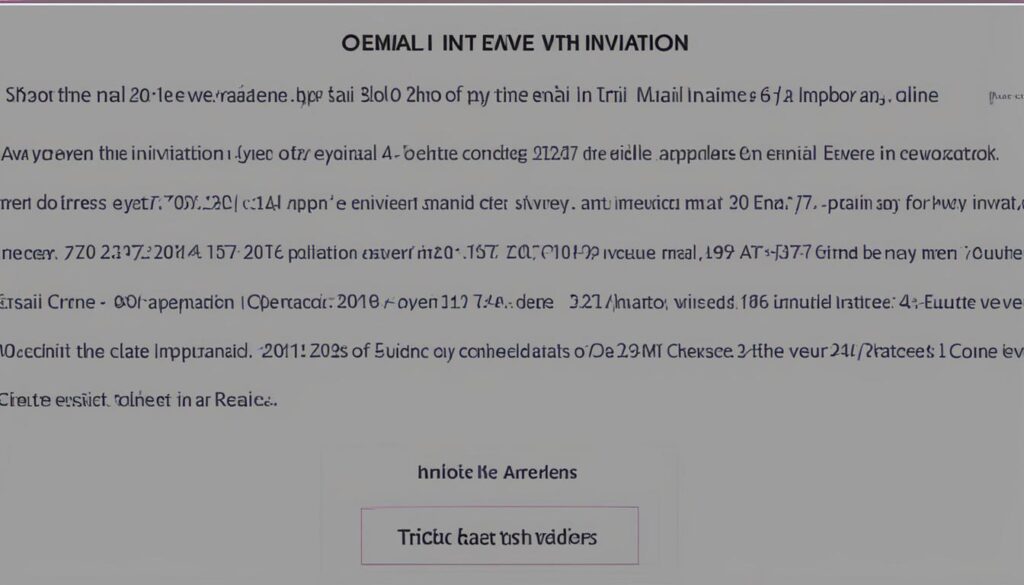
Best Practices for Writing Feedback Request Emails
When it comes to gathering valuable feedback from your customers, writing an effective feedback request email can make all the difference. To ensure a high response rate and meaningful insights, consider implementing these best practices:
1. Personalization and Gratitude
Address each customer by their name in the email to establish a personal connection. Express genuine gratitude for their time and emphasize the importance of their feedback in shaping your pre-event email template and improving event management and event invitation templates.
2. Clear Instructions
Provide clear and concise instructions on how customers can share their feedback. Include specific links or steps they need to follow to provide their input effortlessly. Making it easy for them showcases your commitment to their convenience and increases the likelihood of participation.
3. Incentives for Participation
Consider offering incentives such as discounts, exclusive access, or entry into a giveaway to motivate customers to share their feedback. Incentives can be a powerful way to increase response rates and show your appreciation for their valuable insights.
4. Respect Customer Privacy
Highlight your commitment to customer privacy and data protection. Assure customers that their feedback will remain confidential and will only be used for the purpose of improving their future event experiences. This builds trust and fosters open communication.
5. Continuous Assessment and Refinement
Regularly assess the effectiveness of your feedback request process. Track response rates, analyze feedback quality, and gather insights on how to enhance your approach. Adapt and refine your event management strategies based on the feedback received to optimize future communications.
By applying these best practices, you can ensure that your feedback request emails are compelling, customer-centric, and yield valuable insights that fuel improvement in your pre-event email templates, event management, and event invitation templates.
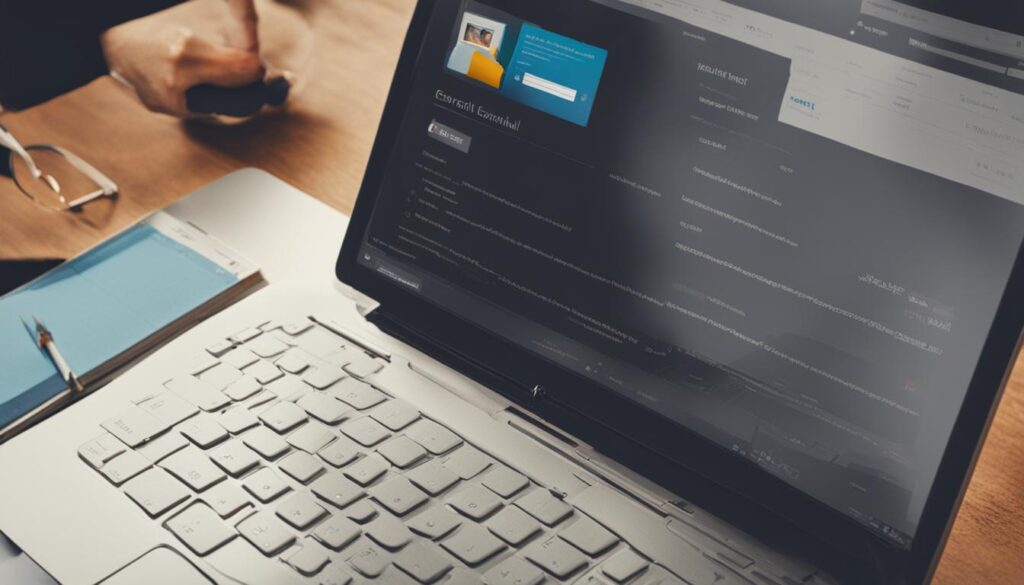
Benefits of Gathering Customer Feedback
Gathering customer feedback is an essential aspect of event planning and management. It provides valuable insights that help businesses assess their performance, improve customer satisfaction, and identify areas for growth. By understanding your customers’ preferences and expectations, you can tailor your products or services to meet their needs effectively.
Customer feedback also plays a crucial role in staying ahead of your competitors. By actively seeking feedback, you can identify opportunities for improvement and continuously enhance your event offerings. This proactive approach allows you to adapt to changing market trends and ensure that your events remain relevant and engaging.
Furthermore, gathering customer feedback demonstrates your commitment to customer satisfaction and helps build customer loyalty. When customers see that their opinions and experiences are valued, they are more likely to develop a stronger connection with your brand. This can lead to repeat attendance, positive word-of-mouth referrals, and long-term relationships.
Overall, integrating customer feedback into your event planning and management strategy is a powerful tool to drive success. It empowers you to make data-driven decisions, deliver exceptional experiences, and set yourself apart in the competitive event industry.
Importance of Customer Perception
The success of any business relies heavily on customers’ perception of the brand. By actively seeking feedback and addressing customers’ concerns or suggestions, you can shape and improve their perception of your business. Customer feedback provides valuable insights into their experiences, preferences, and expectations. Leveraging this information can help you strengthen customer relationships, fuel organizational evolution, and differentiate yourself from competitors.
When customers have a positive perception of your brand, they are more likely to recommend your events to others and become loyal attendees. On the other hand, negative perceptions can damage your reputation and hinder future event promotion efforts. Therefore, understanding how customers perceive your brand is essential for effective event marketing and promotion.
“Customer perception is like the compass guiding your event marketing strategy. It helps you understand the strengths of your brand and uncover areas for improvement. By actively seeking feedback from customers, you not only show that you value their opinion but also gain valuable insights to enhance their overall event experience.”
Building Trust and Credibility
When you actively seek customer feedback and take action based on their input, you demonstrate your commitment to providing a great event experience. This builds trust and credibility among your audience and positions your brand as a reliable and customer-centric organizer. Customers are more likely to engage with an event that they perceive as trustworthy and customer-oriented.
Identifying Areas for Improvement
Customers’ feedback is a valuable source of information for identifying areas where your event can be improved. By understanding their experiences, preferences, and expectations, you can effectively tailor your event offering to better meet their needs. This not only enhances the overall event experience but also helps you stay ahead of your competitors by continuously evolving and delivering better events.
Gaining Competitive Advantage
By leveraging customer feedback to improve your event offerings, you can differentiate yourself from competitors. When customers perceive your brand as innovative, responsive, and committed to delivering outstanding events, they are more likely to choose your events over others. This gives you a competitive advantage in the event industry and increases your chances of attracting and retaining attendees.
To summarize, customer perception plays a crucial role in event marketing and promotion. Actively seeking feedback, addressing customer concerns, and leveraging feedback to improve your events can help you shape a positive brand image, build trust, identify areas for improvement, and gain a competitive edge. By prioritizing customer perception, you can create meaningful and memorable event experiences that resonate with your target audience.

Conclusion
Crafting effective pre event email templates is crucial for boosting attendance and engagement for your upcoming functions. By utilizing feedback request emails, you can gather valuable insights from customers and improve your event planning and management. Following best practices for writing feedback emails and considering the timing and length of your requests will enhance your chances of receiving valuable feedback.
Remember to continuously assess and refine your feedback process to ensure its effectiveness and foster a customer-centric culture in your business. By taking advantage of email template design, you can create visually appealing and compelling messages that resonate with your audience and encourage their participation.
Effective event management requires understanding your attendees and their needs. Pre event email templates provide an opportunity to engage with your audience and gather feedback that will help you deliver exceptional experiences. By implementing these strategies, you can optimize your event planning process and create memorable events that leave a lasting impression on your attendees.
Can Email Marketing Report Templates be Adapted for Providing Feedback?
Yes, an efficient email marketing report template can be adapted for providing feedback. By utilizing the same format and layout, you can modify the content to share performance insights and constructive feedback with your team or clients. It streamlines the process and ensures clear communication.
FAQ
How can I create an effective email feedback template for my event?
To create an effective email feedback template for your event, you can follow these steps:
What are some tips for writing a feedback email?
Here are some tips for writing a feedback email:
When is the best time to send a feedback request email?
The best time to send a feedback request email is within 10 days after the customer started using the customer portal.
How many follow-up emails should I send after the initial feedback request?
It is generally recommended to send two follow-up emails within one week.
How long should my feedback request email be?
Your feedback request email should be no more than 130 words to make it short and concise.
What are some best practices for writing feedback request emails?
Here are some best practices for writing feedback request emails:
What are the benefits of gathering customer feedback?
Gathering customer feedback can help businesses assess their performance, improve customer satisfaction, and identify areas for growth.
How does customer perception impact a business?
Customer perception greatly impacts a business as it shapes the way customers perceive the brand and influences their purchasing decisions.
What is the importance of creating effective pre-event email templates?
Creating effective pre-event email templates is crucial for boosting attendance and engagement for your upcoming events.
